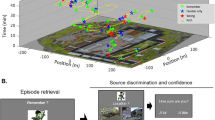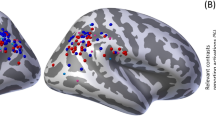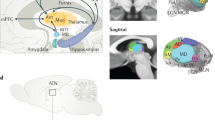Abstract
The contribution of medial temporal lobe structures to memory is well established. However recent brain-imaging studies have indicated that frontal cortex may also be involved in human memory formation. Specific frontal areas are recruited during a variety of procedures that promote memory formation, and the laterality of these areas is influenced by the type of information contained in the memory. Imaging methods that capture momentary changes in brain activity have further shown that the likelihood of memory formation correlates with the level of activity in these areas. These results, taken in the context of other studies, suggest that memory formation depends on joint participation of frontal and medial temporal lobe structures.
This is a preview of subscription content, access via your institution
Access options
Subscribe to this journal
Receive 12 print issues and online access
$209.00 per year
only $17.42 per issue
Buy this article
- Purchase on Springer Link
- Instant access to full article PDF
Prices may be subject to local taxes which are calculated during checkout



Similar content being viewed by others
References
Squire, L. R. Memory and the hippocampus: a synthesis from findings with rats, monkeys, and humans. Psychol. Rev. 99, 195– 231 (1992).
Cohen, N. J. & Eichenbaum, H. Memory, Amnesia, and the Hippocampal System (MIT Press, Cambridge, Massachusetts, 1993).
Schacter, D. L. & Tulving, E. Memory Systems 1994 (MIT Press, Cambridge, Massachusetts, 1994).
Kapur, S. et al. The neural correlates of intentional learning of verbal materials: a PET study in humans. Brain Res. Cogn. Brain Res. 4, 243–249 (1996).
Dolan, R. J. & Fletcher, P. C. Dissociating prefrontal and hippocampal function in episodic memory encoding. Nature 388, 582–585 (1997).
Kelley, W. M. et al. Hemispheric specialization in human dorsal frontal cortex and medial temporal lobe for verbal and nonverbal memory encoding. Neuron 20, 927–936 (1998).
Craik, F. I. M. & Tulving, E. Depth of processing and the retention of words in episodic memory. J. Exp. Psychol. Gen. 104, 168–294 (1975).
Kapur, S. et al. Neuroanatomical correlates of encoding in episodic memory: levels of processing effect. Proc. Natl. Acad. Sci.USA 91, 2008–2011 (1994).
Demb, J. B. et al. Semantic encoding and retrieval in the left inferior prefrontal cortex: a functional MRI study of task difficulty and process specificity. J. Neurosci. 15, 5870– 5878 (1995).
Wagner, A. D. et al. Building memories: remembering and forgetting of verbal experiences as predicted by brain activity Science 281, 1188–1191 (1998).
Craik, F. I., Govoni, R., Naveh-Benjamin, M. & Anderson, N. D. The effects of divided attention on encoding and retrieval processes in human memory. J. Exp. Psychol. Gen. 125, 159– 180 (1996).
Shallice, T. et al. Brain regions associated with acquisition and retrieval of verbal episodic memory. Nature 368, 633– 635 (1994).
Fabiani, M., Karis, M. & Donchin, E. P300 and recall in an incidental memory paradigm. Psychophysiology 23, 298–308 (1986).
Paller, K. A. Recall and stem-completion priming have different electrophysiological correlates and are modified differentially by directed forgetting. J. Exp. Psychol. Learn. Mem. Cogn. 16, 1021– 1032 (1990).
Rugg, M. D. in Electrophysiology of Mind: Event-Related Brain Potentials and Cognition (eds. Rugg, M. D. & Coles, M. G. H.) 132–170 (Oxford Univ. Press, Oxford, 1995).
Buckner, R. L. et al. Detection of cortical activation during averaged single trials of a cognitive task using functional magnetic resonance imaging. Proc. Natl. Acad. Sci. USA 93, 14878– 14883 (1996).
Dale, A. M. & Buckner, R. L. Selective averaging of rapidly presented individual trials using fMRI. Hum. Brain Mapp. 5, 329–340 (1997).
Josephs, O., Turner, R. & Friston, K. Event-related fMRI. Hum. Brain Mapp. 5, 243–248 (1997).
Kim, S. G., Richter, W. & Ugurbil, K. Limitations of temporal resolution in functional MRI. Magn. Reson. Med. 37, 631– 636 (1997).
Zarahn, E., Aguirre, G. & D'Esposito, M. A trial-based experimental design for fMRI. Neuroimage 6, 122–138 (1997).
Brewer, J. B., Zhao, Z., Glover, G. H. & Gabrieli, J. D. E. Making memories: brain activity that predicts how well visual experience will be remembered. Science 281,1185– 1187 (1998).
Tulving, E., Kapur, S., Craik, F. I. M., Moscovitch, M. & Houle, S. Hemispheric encoding/retrieval asymmetry in episodic memory: positron emission tomography findings. Proc. Natl. Acad. Sci. USA 91, 2016–2020 (1994).
Paivio, A. & Csapo, K. Picture superiority in free recall: imagery or dual coding? Cogn. Psychol. 5, 176–206 (1973).
Paivio, A. Mental Representations (Oxford Univ. Press, New York, 1986).
Milner, B. & Taylor, L. Right-hemisphere superiority in tactile pattern-recognition after cerebral commissurotomy: evidence for nonverbal memory. Neuropsychologia 10, 1– 15 (1972).
Gazzaniga, M. S. & Smylie, C. S. Facial recognition and brain asymmetries: clues to underlying mechanisms. Ann. Neurol. 13, 536–540 (1983).
Milner, B. Some cognitive effects of frontal-lobe lesions in man. Phil. Trans. R. Soc. Lond. B 298, 211–226 (1982).
Jones-Gotman, M. & Milner, B. Design fluency: the invention of nonsense drawings after focal cortical lesions. Neuropsychologia 15, 653–674 (1977).
Wagner, A. D. et al. Material-specific lateralization of prefrontal activation during episodic encoding and retrieval. Neuroreport 9, 3711–3717 (1998).
Haxby, J. V. et al. Face encoding and recognition in the human brain. Proc. Natl. Acad. Sci.USA 93, 922– 927 (1996).
Grady, C. L. et al. Age-related reductions in human recognition memory due to impaired encoding. Science 269, 218– 221 (1995).
Milner, B., Petrides, M. & Smith, M. L. Frontal lobes and the temporal organization of memory. Hum. Neurobiol. 4, 137– 142 (1985).
Shimamura, A. P., Janowsky, J. S. & Squire, L. R. in Frontal Lobe Function and Dysfunction (eds. Levin, H., Eisenberg, H. M. & Benton, A. L.) 173– 198 (Oxford Univ. Press, New York, 1991).
Schacter, D. L. Memory, amnesia, and frontal lobe dysfunction. Psychobiology 15, 21–36 (1987).
Stuss, D. T. & Benson, D. F. The Frontal Lobes (Raven, New York, 1986).
Fuster, J. M. The Prefrontal Cortex (Raven, New York, 1989).
Goldman-Rakic, P. S. in The Handbook of Physiology: Section 1. The Nervous System: Vol. V Higher functions of the brain: (eds. Plum, F. & Mountcastle, V.) Pt. 1, 373–417 (American Physiological Society, Bethesda, Maryland, 1987).
Smith, E. E. & Jonides, J. Working memory: a view from neuroimaging. Cogn. Psychol. 33, 5–42 (1997).
Buckner, R. L. & Tulving, E. in Handbook of Neuropsychology (eds. Boller, F. & Grafman, J.) 439– 466 (Elsevier, Amsterdam, 1995).
Riege, W. H., Metter, E. J. & Hanson, W. R. Verbal and nonverbal recognition memory in aphasic and nonaphasic stroke patients. Brain Lang. 10, 60–70 (1980).
Whitehouse, P. J. Imagery and verbal encoding in left and right hemisphere damaged patients. Brain Lang. 14, 315–332 (1981).
Corkin, S. Lasting consequences of bilateral medial temporal lobe lobectomy: Clinical course and experimental finding in H.M. Semin. Neurol. 4, 249–259 (1984).
Hyman, B. T., Van Horsen, G. W., Damasio, A. R. & Barnes, C. L. Alzheimer's disease: cell-specific pathology isolates the hippocampal formation. Science 225, 1168–1170 (1984).
Samuel, W., Masliah, E., Hill, L. R., Butters, N. & Terry, R. Hippocampal connectivity and Alzheimer's dementia: effects of synapse loss and tangle frequency in a two-component model. Neurology 44, 2081–2088 (1994).
Price, J. L., Davis, P. B., Morris, J. C. & White, D. L. The distribution of tangles, plaques and related immunohistochemical markers in healthy aging and Alzheimer's disease. Neurobiol. Aging 12, 295–312 (1991).
Zola-Morgan, S. & Squire, L. R. Neuroanatomy of memory. Annu. Rev. Neurosci. 16, 547– 563 (1993).
Murray, E. A. What have ablation studies told us about neural substrates of stimulus memory? Semin. Neurosci. 8, 13– 22 (1996).
Schacter, D. L. & Wagner, A. D. Medial temporal lobe activations in fMRI and PET studies of episodic encoding and retrieval. Hippocampus 9, 7–24 (1999).
Buckner, R. L. & Koutstaal, W. Functional neuroimaging studies of encoding, priming, and explicit memory retrieval. Proc. Natl. Acad. Sci. USA 95, 891–898 (1998).
Moscovitch, M. Memory and working-with-memory: A component process model based on modules and central systems. J. Cogn. Neurosci. 4, 257–267 (1992).
Cohen, N. J. et al. Hippocampal system and declarative (relational) memory: Summarizing from functional neuroimaging studies. Hippocampus 9, 83–98 (1999).
Martin, A., Wiggs, C. L. & Weisberg, J. Modulation of human medial temporal lobe activity by form, meaning, and experience. Hippocampus 7, 587–593 (1997).
Stern, C. E. et al. The hippocampal formation participates in novel picture encoding: evidence from functional magnetic resonance imaging. Proc. Natl. Acad. Sci. USA 93, 8660–8665 (1996).
Tulving, E., Markowitsch, H. J., Craik, F. I. M., Habib, R. & Houle, S. Novelty and familiarity activations in PET studies of memory encoding and retrieval. Cereb. Cortex 6, 71–79 (1996).
Gabrieli, J. D. E., Poldrack, R. A. & Desmond, D. E. The role of left prefrontal cortex in language and memory. Proc. Natl. Acad. Sci. USA 95, 906–913 (1998).
Acknowledgements
Neal Cohen, Anthony Wagner, David Donaldson, Jessica Logan and Amy Sanders provided comments. This work was supported by grants from the National Institute of Mental Health (MH57506-01), the McDonnell Center for Higher Brain Function and the Human Frontiers Science Program.
Author information
Authors and Affiliations
Corresponding author
Rights and permissions
About this article
Cite this article
Buckner, R., Kelley, W. & Petersen, S. Frontal cortex contributes to human memory formation. Nat Neurosci 2, 311–314 (1999). https://doi.org/10.1038/7221
Received:
Accepted:
Issue Date:
DOI: https://doi.org/10.1038/7221
This article is cited by
-
A functional neuroimaging study of self-other processing alterations in atypical developmental trajectories of psychotic-like experiences
Scientific Reports (2022)
-
The Impact of the Combined Administration of 1MeTIQ and MK-801 on Cell Viability, Oxidative Stress Markers, and Glutamate Release in the Rat Hippocampus
Neurotoxicity Research (2021)
-
Disrupted parahippocampal and midbrain function underlie slower verbal learning in adolescent-onset regular cannabis use
Psychopharmacology (2021)
-
Contextual experience modifies functional connectome indices of topological strength and efficiency
Scientific Reports (2020)
-
Age-associated reorganization of metabolic brain connectivity in Chinese children
European Journal of Nuclear Medicine and Molecular Imaging (2020)



